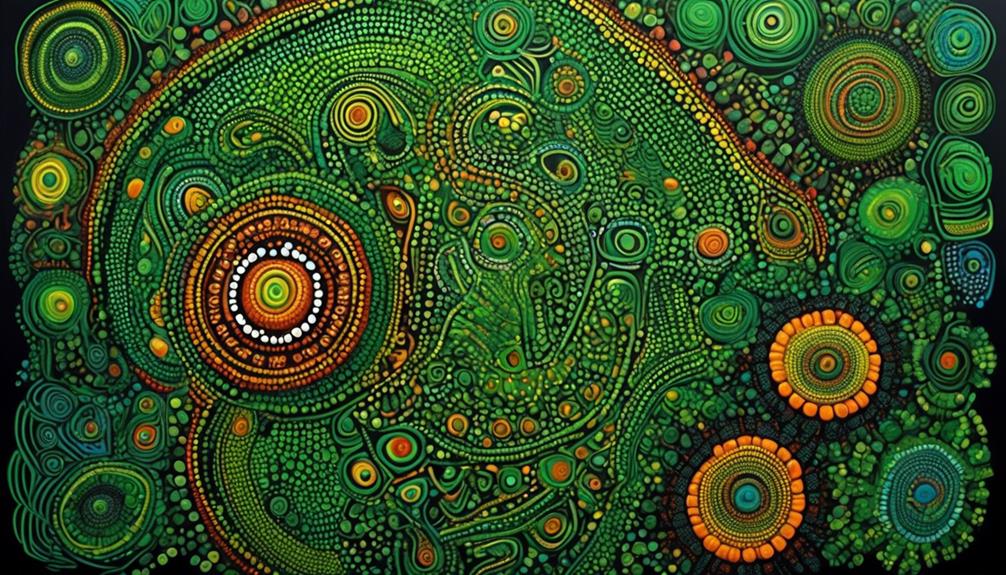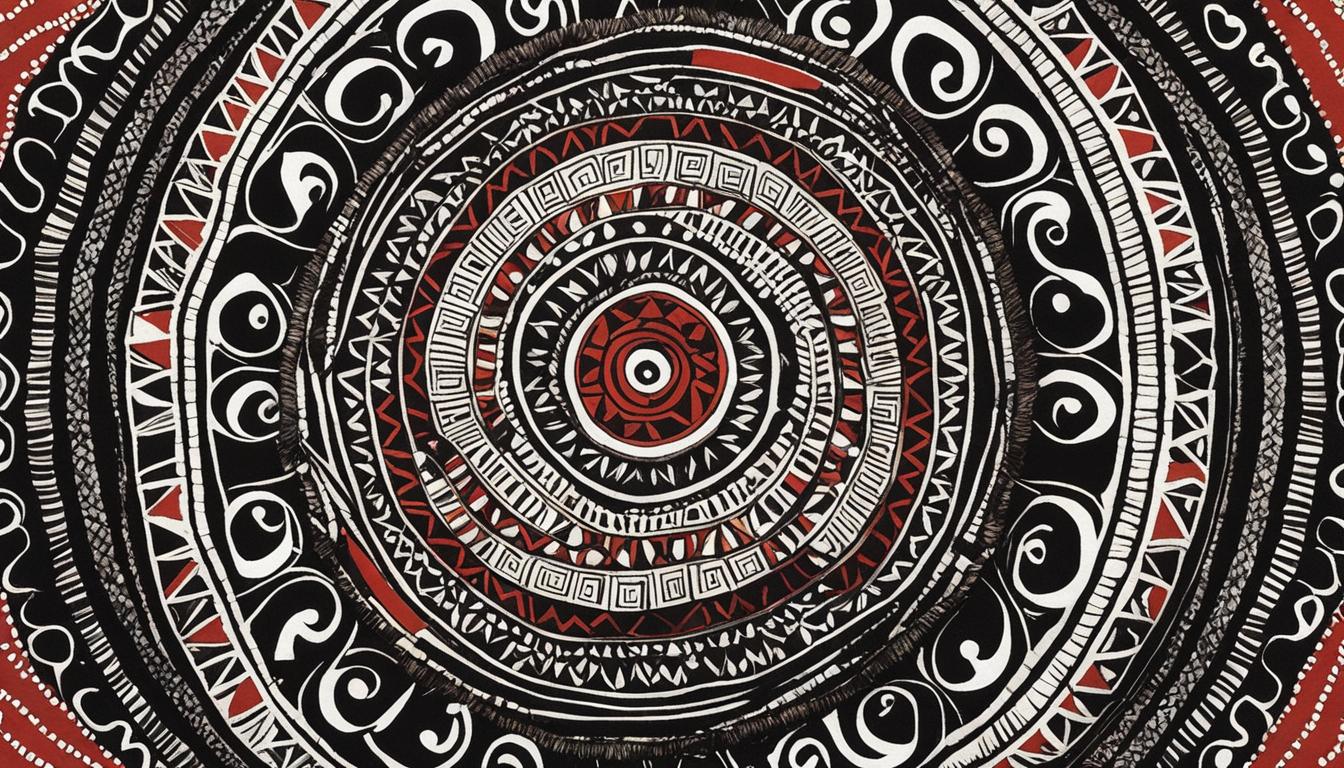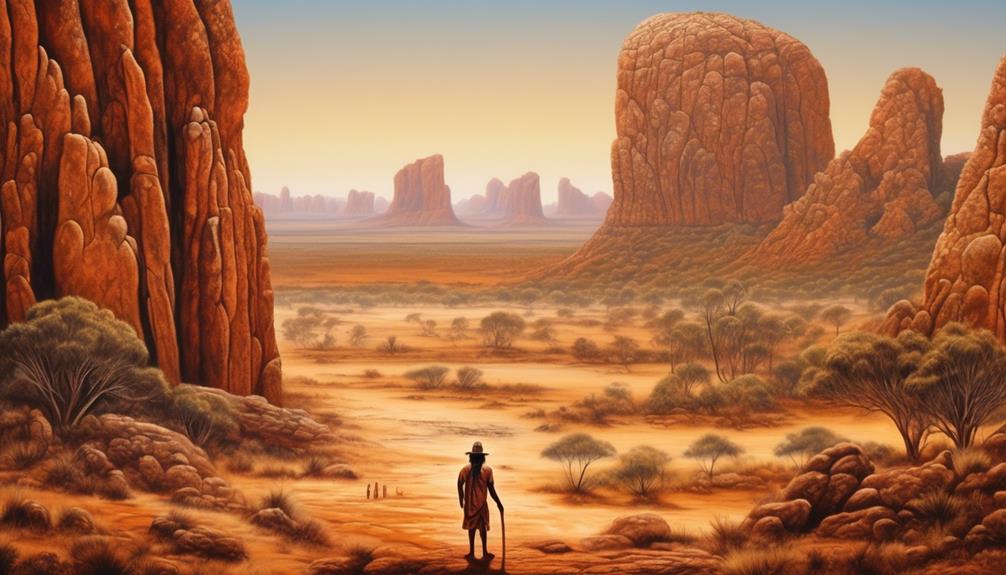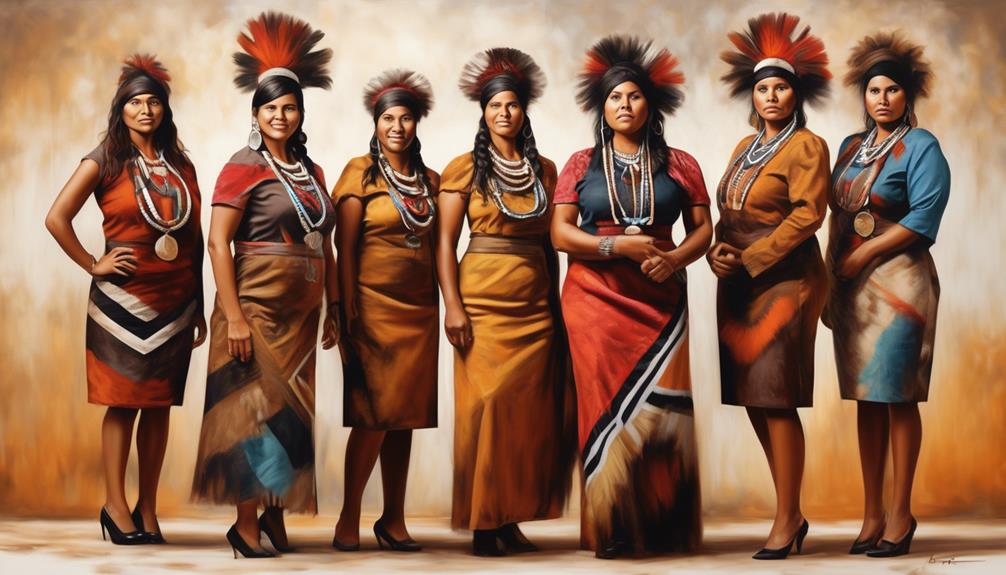Exploring Aboriginal art is like discovering the many layers of a vibrant and ever-changing landscape. By combining traditional Indigenous art techniques with sustainable materials, it sparks a dialogue that is as diverse and intricate as our own planet.
In this discussion, we'll delve into the profound connection between cultural heritage and environmentalism, shining a light on the sustainable practices in Aboriginal art and the indigenous perspectives on conservation.
There's a fascinating story to be told about the ways in which art, culture, and environmental consciousness intertwine in the realm of Green Aboriginal Art.
Key Takeaways
- Indigenous brushwork techniques convey narratives, traditions, and sacred knowledge.
- Eco-friendly material innovations and sustainable practices in Aboriginal art minimize environmental impact and preserve cultural heritage.
- Indigenous communities offer invaluable perspectives rooted in cultural wisdom and prioritize sustainability and long-term ecosystem health.
- The combination of cultural heritage and environmentalism in Aboriginal art promotes environmental stewardship and sustainable practices.
Traditional Indigenous Art Techniques
Exploring the traditional Indigenous art techniques reveals a deep connection to cultural heritage, spiritual symbolism, and storytelling within the Aboriginal community. Indigenous brushwork techniques are integral to this art form, embodying a profound understanding of the natural world and the interconnectedness of all living things. The strokes and patterns applied with precision convey not just images, but narratives, traditions, and sacred knowledge passed down through generations.
In the creation of Indigenous art, natural pigment sourcing is a meticulous process that reflects a deep respect for the land. The sourcing of pigments from the earth, plants, and minerals is a deliberate and spiritual practice, often involving ceremonies and rituals to honor the elements. The colors derived from these natural sources not only imbue the artwork with vibrant hues but also carry symbolic significance, representing the interconnectedness of the Aboriginal people with their environment. Each color holds its own story, embodying the essence of the land, the spirits, and the ancestral wisdom.
Understanding these traditional techniques reveals a profound insight into the Aboriginal culture, offering a glimpse into their rich heritage, spiritual beliefs, and deep connection to the natural world.
Eco-Friendly Material Innovations

The traditional Indigenous art techniques, with their deep respect for the land and its resources, have inspired a new wave of eco-friendly material innovations rooted in cultural heritage and sustainability.
As artists and artisans seek to honor their ancestral practices while embracing environmentally conscious methods, the development of eco-friendly materials has become paramount. This movement has led to the rise of biodegradable pigments, which not only pay homage to the earth but also minimize the ecological footprint of art creation.
Furthermore, renewable fiber options such as organic cotton, hemp, and bamboo have gained prominence for their sustainable qualities, offering artists a way to connect with nature through their materials. The use of these renewable fibers not only aligns with Indigenous values of living in harmony with the natural world but also promotes a more sustainable approach to art production.
Incorporating these eco-friendly material innovations into artistic practices not only preserves cultural heritage but also signifies a commitment to environmental stewardship and a harmonious relationship with the land.
Cultural Heritage and Environmentalism
In our exploration of the intersection between cultural heritage and environmentalism, we uncover the profound significance of traditional Indigenous art practices in fostering a deep-rooted connection to the natural world.
Indigenous communities have long been at the forefront of environmental stewardship, with their art serving as a powerful medium for expressing their deep-seated connection to the land. Through art, Indigenous peoples convey their intimate relationship with the environment, embodying a profound understanding of the interconnectedness of all living things. This cultural heritage isn't only a source of artistic inspiration but also a form of Indigenous activism, advocating for the preservation of the natural world.
The symbiotic relationship between Indigenous art and environmental activism is deeply rooted in the cultural context of Indigenous communities. Traditional art forms often carry symbolic interpretations of the natural world, encapsulating the wisdom passed down through generations. This artistic expression not only reflects the reverence for the environment but also serves as a call to action, urging environmental stewardship and sustainable practices.
It's through these art forms that Indigenous communities advocate for the protection of their ancestral lands and the promotion of ecological balance.
Sustainable Practices in Aboriginal Art

Embedded within the traditional art forms of Indigenous communities, the concept of sustainability is intrinsically woven, reflecting a deep-rooted ethos of environmental reverence and stewardship. Indigenous craftsmanship stands as a testament to the harmonious relationship between art and nature, showcasing sustainable practices that have been passed down through generations.
The methods and materials used in creating Aboriginal art exemplify a profound respect for the environment, as artists employ eco-friendly techniques that minimize ecological impact.
- Utilization of Natural Resources: Aboriginal artists often gather materials from the land, such as natural pigments, clay, and plant-based dyes, ensuring minimal disruption to the environment.
- Traditional Techniques and Innovation: The blending of traditional craftsmanship with innovative approaches results in the creation of art that isn't only aesthetically captivating but also environmentally sustainable.
- Cyclical Philosophies: The cyclical philosophies inherent in Indigenous cultures are reflected in the use of sustainable materials and the practice of ensuring that the land remains fruitful for future generations.
- Community-Based Sustainability: Aboriginal art often involves communal efforts, with the knowledge and techniques of sustainability being shared among community members, fostering a collective responsibility for environmental stewardship.
Indigenous Perspectives on Conservation
With a deep connection to the land and a profound respect for nature, Indigenous communities offer invaluable perspectives on conservation that are rooted in centuries of cultural wisdom and symbiotic relationships with the environment. Indigenous knowledge of environmental stewardship is deeply embedded in their cultures and traditions. It encompasses a holistic understanding of the interconnectedness of all living beings and the environment. This understanding is reflected in their practices, which prioritize sustainability and the long-term health of ecosystems.
Indigenous perspectives on conservation aren't only practical but also deeply symbolic. The concept of 'caring for country' is central to many Indigenous belief systems, emphasizing the responsibility of humans to nurture and protect the land. This spiritual connection to the natural world shapes their approach to conservation, instilling a sense of reverence and guardianship.
Furthermore, Indigenous communities often employ traditional ecological knowledge, passed down through generations, to inform their conservation efforts. This knowledge is based on keen observations of the environment and is complemented by cultural stories and practices that reinforce the importance of living in harmony with nature.
In embracing Indigenous perspectives, modern conservation efforts can benefit from a more comprehensive and culturally sensitive approach that recognizes the deep wisdom and sustainable practices of these communities.
Frequently Asked Questions
How Has the Modern Environmental Movement Influenced the Subject Matter of Contemporary Aboriginal Art?
The modern environmental movement has greatly influenced the subject matter of contemporary Aboriginal art. The influence of activism has sparked a shift towards themes of conservation, sustainability, and the interconnectedness of nature.
This aligns with the traditional cultural storytelling in art, where Aboriginal artists use symbolism to convey their deep connection to the land and the importance of preserving it for future generations.
This intersection of environmental activism and cultural storytelling has brought a powerful new dimension to contemporary Aboriginal art.
What Are Some Traditional Indigenous Art Techniques That Are Being Revitalized and Incorporated Into Modern Eco-Friendly Art Practices?
Traditional techniques are being revitalized and incorporated into modern eco-friendly art practices. Indigenous art forms, such as bark painting, dot painting, and rock art, are being reimagined to convey environmental messages.
Artists are using natural materials and long-lasting methods to reflect indigenous conservation efforts. By integrating cultural inspiration with artistic perspective, this revitalization of traditional techniques is creating impactful art with a deep connection to the environment.
How Do Aboriginal Artists Balance the Use of Natural Materials With the Need for Long-Lasting and Durable Art Pieces?
Balancing the use of natural materials with the need for long-lasting and durable art pieces requires sustainable creativity and natural resilience.
Aboriginal artists draw from their cultural heritage to create art that embodies both artistic durability and environmental inspiration.
By incorporating traditional techniques and eco-friendly practices, they honor their ancestors while adapting to modern challenges.
This approach reflects a deep connection to the land and a commitment to preserving it for future generations.
Are There Specific Cultural Traditions or Stories That Inspire Aboriginal Artists to Create Art With an Environmental Message?
Specific cultural traditions deeply inspire Aboriginal artists. These traditions are rooted in the rich tapestry of Indigenous storytelling, which imparts vital lessons about our interconnectedness with the natural world.
Leading to the creation of art pieces with a powerful environmental message. Through their art, Aboriginal artists skillfully weave together cultural inspiration and environmental storytelling.
Prompting viewers to reflect on the importance of sustainability and our responsibility to protect the Earth.
How Do Indigenous Perspectives on Conservation Differ From Mainstream Environmental Movements, and How Does This Influence Their Artistic Practice?
Indigenous perspectives on conservation take a holistic approach, deeply rooted in cultural traditions. This influences our artistic practice by intertwining environmental stewardship with storytelling traditions. Our conservation methods reflect a profound connection to the land and its resources, shaping our artistic expression.
Unlike mainstream environmental movements, our focus is on a symbiotic relationship with nature, drawing inspiration from our cultural heritage to convey a message of harmony and balance.
Conclusion
In conclusion, green Aboriginal art is a powerful expression of cultural heritage and environmental consciousness.
For example, the use of natural pigments and sustainable materials in traditional Indigenous art not only preserves cultural traditions but also minimizes environmental impact.
By embracing eco-friendly practices, Indigenous artists are promoting conservation and sustainability while creating beautiful and meaningful works of art that connect with the natural world.
Talise is a talented writer and an expert in her field. Her unique perspective and insights enrich our content with depth and authenticity. With a wealth of knowledge and a strong connection to the subjects she writes about, Talise crafts engaging and informative articles that resonate with our readers. Her dedication to bringing Indigenous culture and wisdom to light is truly commendable.










